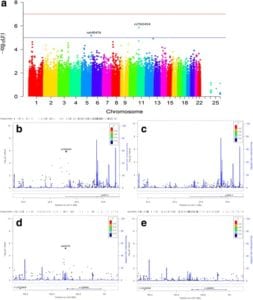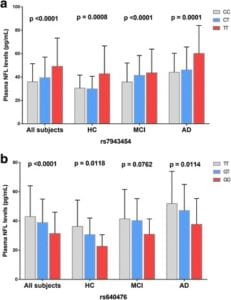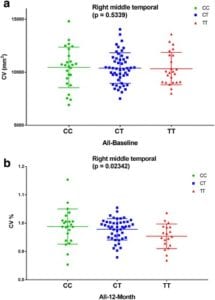Genome-wide Association Study Identifies Two Loci Influencing Plasma Neurofilament Light Levels
BMC MEDICAL GENOMICS
Li JQ, Yuan XZ, Li HY, Cao XP, Yu JT, Tan L and Chen WA
BMC Med Genomics. 2018 May 10;11(1):47
DOI: 10.1186/s12920-018-0364-8.
This study was peformed using a Simoa® Homebrew assay.
Abstract
Background:
Plasma neurofilament light (NFL) is a promising biomarker for Alzheimer disease (AD), which increases in the early stage of AD and is associated with the progression of AD. We performed a genome-wide association study (GWAS) of plasma NFL in Alzheimer’s Disease Neuroimaging Initiative 1 (ADNI-1) cohort to identify novel variants associated with AD.
Methods:
This study included 179 cognitively healthy controls (HC), 176 patients with mild cognitive impairment (MCI), and 172 patients with AD. All subjects were restricted to non-Hispanic Caucasian derived from the ADNI cohort and met all quality control (QC) criteria. Association of plasma NFL with the genetic variants was assessed using PLINK with an additive genetic model, i.e.dose-dependent effect of the minor alleles. The influence of a genetic variant associated with plasma NFL (rs7943454) on brain structure was further assessed using PLINK with a linear regression model.
Results:
The minor allele (T) of rs7943454 in leucine zipper protein 2 gene (LUZP2) was associated with higher plasma NFL at suggestive levels (P = 1.39 × 10- 6) in a dose-dependent fashion. In contrast, the minor allele (G) of rs640476 near GABRB2 was associated with lower plasma NFL at suggestive levels (P = 6.71 × 10- 6) in a dose-dependent effect in all diagnostic groups except the MCI group. Furthermore, the minor allele (T) of rs7943454 within LUZP2 increased the onset risk of AD (odds ratio = 1.547, confidence interval 95% = 1.018-2.351) and was associated with atrophy of right middle temporal gyrus in the whole cohort in the longitudinal study (P = 0.0234).
Conclusion:
GWAS found the associations of two single nucleotide polymorphisms (rs7943454 and rs640476) with plasma NFL at suggestive levels. Rs7943454 in LUZP2 was associated with the onset risk of AD and atrophy of right middle temporal gyrusin the whole cohort. Using an endophenotype-based approach, we identified rs7943454 as a new AD risk locus.

Fig. 1
Manhattan and regional plots for associations with plasma NFL levels. a Genome-wide signal intensity (Manhattan) plots showing the –log10 (p-value) for individual SNPs. b Regional association results for the 24.2 Mb to 24.8 Mb region of chromosome 11. c Association results for 24.2 Mb to 24.8 Mb region of chromosome 11 controlling for rs7943454. dRegional association results for the 160.4 Mb to 161 Mb regions of chromosome 5. e Association results for 160.4 Mb to 161 Mb regions of chromosome 5 controlling for rs640476
Jie-Qiong Li, et al. BMC Med Genomics. 2018;11:47.

Fig. 2.
Mean plasma NFL levels of different diagnostic groups and genotypes. Mean and standard errors of plasma NFL levels are shown for groups defined by baseline diagnosis and genotypes. P < 0.05 was considered statistically significant after examination with a multiple linear regression model using age, gender and the diagnosis as covariates. a The minor alleleofrs7943454 (T) showed association with higher plasma NFL levels in a dose-dependent effect in all diagnostic groups. b The minor allele of rs640476 (G) showed association with lower plasma NFL levels in a dose-dependent effect in all diagnostic groups except the MCI group
Jie-Qiong Li, et al. BMC Med Genomics. 2018;11:47.

Fig. 3.
Rs7943454 and right middle temporal gyrus. a The volume of right middle temporal gyrus was not associated with rs7943454 at baseline in the whole cohort (P = 0.5339). b Rs7943454 increase the percentage of atrophy of right middle temporal gyrus in the whole cohort in the following-up research of 1 year (P = 0.0234). Subjects with TT genotypes had greater atrophy rate of right middle temporal gyrus than those with CC genotypes (P = 0.05)
Jie-Qiong Li, et al. BMC Med Genomics. 2018;11:47.